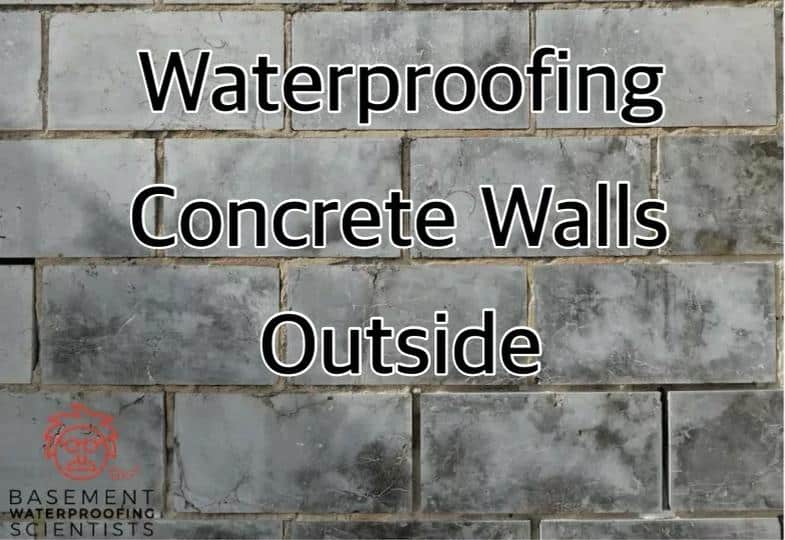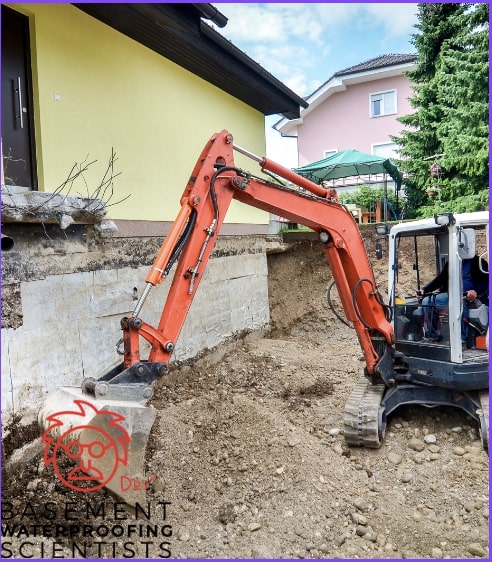
Your home is not only your sanctuary but also one of the most significant investments you will ever make. Ensuring its longevity involves regular maintenance and care, one vital aspect of which is waterproofing your outdoor cinder block basement walls. This blog post serves as a comprehensive guide to help you better understand the importance of this task and how to accomplish it efficiently. Exterior Waterproofing

Why Do Exterior Concrete Block Waterproofing?
Concrete blocks are a popular choice for building outdoor walls due to their durability and aesthetics. However, these are hollow blocks, and their susceptibility to absorb moisture can lead to a host of problems, including structural damage and mold growth. By waterproofing your outdoor cinder blocks, you effectively safeguard your property from water-related issues and contribute to its long-lasting durability. Waterproofing from the outside will prevent moisture from entering the hollow cores of the concrete block wall.
Step-by-Step Guide to Waterproofing Your Concrete Block Walls
Waterproofing your outdoor concrete block involves a systematic process, which, when followed meticulously, ensures maximum effectiveness. This is a form of interior waterproofing although to ensure you don’t have a leaking basement from hydrostatic pressure you may need other waterproofing work.
Step 1: Excavate The Soil Around The Foundation and Clean the Wall Surface
While excavating the soil around cinder block walls during exterior waterproofing, be careful not to damage the concrete masonry units with the back hoe. Then, give the block foundation wall a thorough cleaning. Use a stiff brush to eliminate dirt, grime, and any loose material. For more stubborn dirt, a power washer could be a great tool to utilize. Ensuring your walls are clean provides a better surface for the sub grade block waterproofing agent to adhere to.
Step 2: Repairing Existing Damage
Inspect your basement wall carefully for any signs of damage or cracks. Use a concrete repair compound to fill these exterior walls and allow it to cure as per the manufacturer’s instructions. By sealing these potential entry points for water, you strengthen the efficacy of the waterproofing process. Place hydraulic cement in any cracked mortar joints.
3: Selecting and Applying a Waterproofing Agent
There is a wide range of products available for waterproofing outdoor concrete block foundation. Select one designed for this specific purpose and apply according to the manufacturer’s guidelines. Typically, this involves applying at least two coats, allowing sufficient drying time between each. This creates a robust exterior barrier that prevents moisture infiltration. There is also single coat waterproof membrane which can be very effective for waterproofing foundations. This application should be performed by an experienced basement waterproofing contractor like the Basement Waterproofing Scientists.
Step 4: Replace Soil Backfill Around the Cinder Blocks
After successfully waterproofing your walls, ensure that you properly replace the backfill soil. Adding a layer of foam insulation against the concrete block sealer or exterior waterproofing membrane will protect it. In some cases the addition of an interior weeping tile system or french drain will also be necessary to keep water from penetrating and getting on the cement basement floor and block foundation walls. Foundations can be made waterproof through sealing the block and installing sup-floor foundation waterproofing drainage.
Picking the Right Waterproofing Product
The market offers an extensive variety of block foundation waterproofing agents suitable for concrete block foundation walls, each with its unique properties. Some of the most reliable ones include silicone-based sealants, acrylic-based paints, and elastomeric coatings. When choosing, ensure the product is intended for outdoor use and can withstand the rigors of your local weather conditions. In addition to waterproof membrane application to the block foundation walls, the footing should also be sealed. This is typically referred to as external waterproofing. This process can be used on concrete block foundations as well as poured concrete walls and is referred to as positive side waterproofing.
Waterproofing Block Foundation Walls From The Outside

Waterproofing your outdoor cinder block foundation is a proactive measure that can save you from costly repairs from water intrusion in the future. With the right approach, products, and a bit of time, you can effectively protect your property and ensure it’s longevity. Always remember, the key to maintaining a watertight home is regular inspection and timely maintenance. Concrete block construction is prone to moisture intrusion from the water pressure exerted on the initial waterproof sealant.
Get Your Cinder Blocks and Basement Walls Waterproof Today!
Don’t let the task of waterproofing intimidate you. Equip yourself with the right knowledge and tools and start waterproofing your cinder block walls today. Your home will thank you! Basement Waterproofing Scientists performs all kinds of waterproofing work. From fluid applied liquid membrane concrete sealers, injected resins, or sub foundation drainage that lowers the water table from getting to the finished basement walls we’ve got you covered.
Will Exterior Waterproofing Concrete Block Walls Outside Keep Me Dry?
This will depend on the way the home was constructed. Was there drain tile installed? In concrete CMU walls, water can build up in the hollow blocks. When these remain with water trapped inside this can cause deterioration. Water pressure can also build up beneath the basement foundation walls as well as in the cinder blocks. To prevent this moisture from spilling on to the basement floor sub grade pressure relief systems should be employed. This kind of foundation waterproofing will drain the cinder blocks into the below grade sub-floor pipe.

